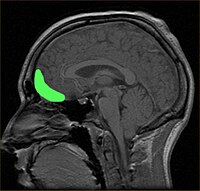
Photo from wikipedia
In this study, we examined the interaction of automatic (i.e., automatic affective evaluations) and reflective [i.e., reflective intention and executive functions (EFs)] processes on physical activity (PA) behavior based on… Click to show full abstract
In this study, we examined the interaction of automatic (i.e., automatic affective evaluations) and reflective [i.e., reflective intention and executive functions (EFs)] processes on physical activity (PA) behavior based on dual-process theories. We expected main effects as well as significant interaction effects between automatic associations, intention, and EFs on behavior. In particular, a well-controlled implicit-association-test (IAT) was applied to assess automatic affective evaluation. A prospective study with two points of measurement (N=212 students) was conducted. At t1, age, sex, PA behavior (control variables), automatic associations, EFs (shifting, updating, inhibition), and PA intention (predictors and moderators) were assessed with standardized questionnaires and tests. At t2 (4weeks later), PA behavior (dependent variable) was measured with a standardized questionnaire. A hierarchical multiple linear regression analysis including two- and three-way interactions between IAT results, intention, and EFs on PA behavior was conducted. Results showed that the interactions Intention x Shifting and IAT x Intention x Inhibition were significant. Moderation analyses revealed that participants with higher intentions and lower inhibition values (improved inhibition abilities) showed a negative association between IAT and PA, while those with lower intentions and lower inhibition values showed a positive association between IAT and PA, which was documented in a significant slope difference test between these two groups. Thus, both automatic and reflective processes contribute and interact in predicting PA. As well as fostering more positive affective evaluations towards PA, interventions to strengthen PA intentions and to improve EFs could help to increase PA behavior.
Journal Title: Frontiers in Psychology
Year Published: 2021
Link to full text (if available)
Share on Social Media: Sign Up to like & get
recommendations!